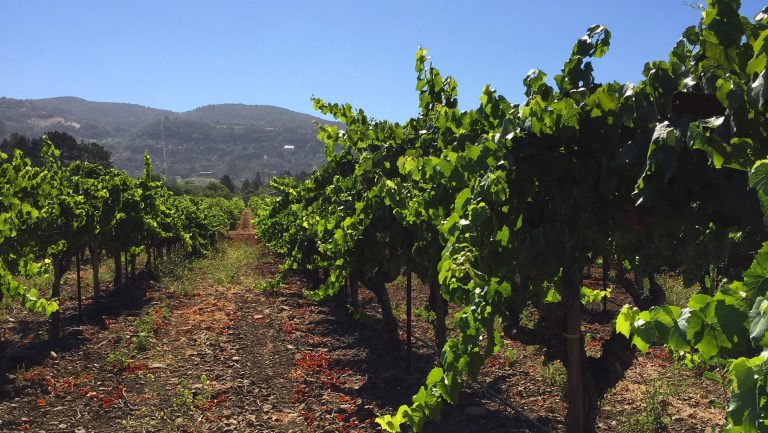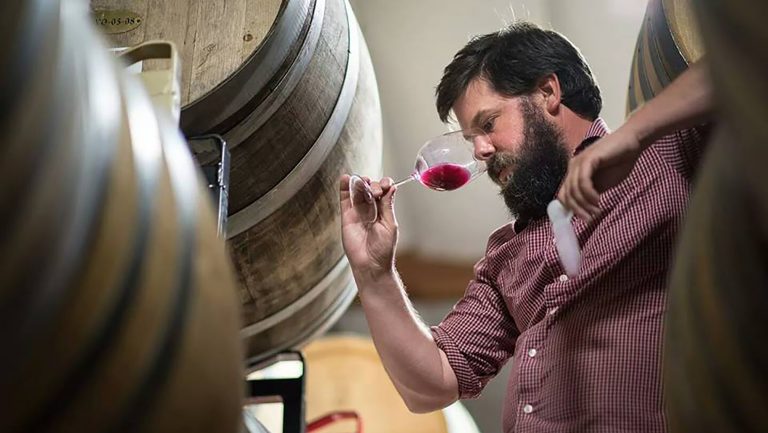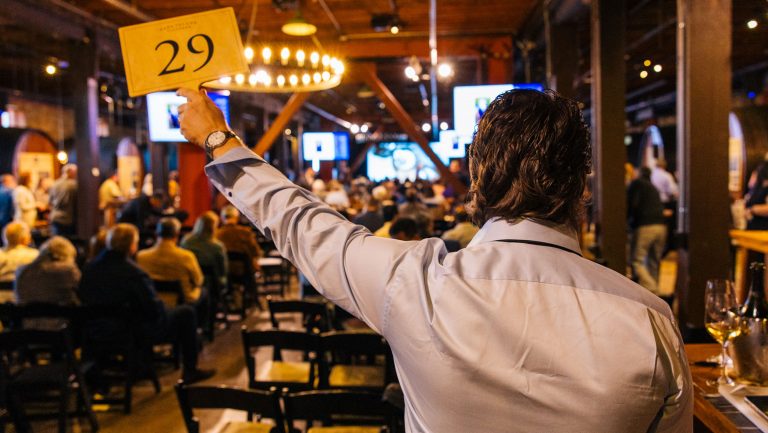It’s an uphill climb to start from scratch as a winemaker in Napa Valley.
The type of wine that appeals to the current generation of wine writers and sommeliers isn’t the style Napa made famous in the last 20 years. And the price of entry for Napa wines is the highest in California—for both a fledgling producer and the final consumer. Grape, land, and labor prices in this finite valley continue to rise. There is always talk of points and scores. Any new Napa-based brands that aren’t designed to attract high-income customers and investors probably don’t pencil out. Is it possible to start anything new in Napa Valley that doesn’t feel immediately excessive? Is it possible for someone to bootstrap a successful wine brand with a New California ethos in the valley today?
In the mid-2000s, the New California movement was born out of nostalgia, a discomfort with the overt and heavy wines of the day, and a dash of economic reality. Often, New California is catchall for producers who adhere to one or more of the following tenets: they farm cleanly; they prefer acidity to alcohol as a driving force; they advertise a laissez-faire approach to winemaking; they play with skin contact for white wines and stem contact for reds; they veer “natural” in flavor and fashion; they disdain oak barrels, unless the barrels are old. Obscure varieties from peripheral vineyards were seen as not just interesting but also less expensive to produce. Dan Petroski, the winemaker for Larkmead Vineyards and Massican in the Napa Valley, asserts “the New California movement wouldn’t exist if all Cabernet was $30 a bottle.”

Don’t miss the latest drinks industry news and insights. Sign up for our award-winning newsletters and get insider intel, resources, and trends delivered to your inbox every week.
In the early days of the movement, winemakers in Sonoma County led the charge. Nowadays, one finds New California–style wines up and down the state. Every appellation in California, it seems, produced its own band of like-minded revolutionaries—everywhere save the most obvious emblem of the previous regime: Napa Valley.
Napa Valley has seemed impervious to the New California wave, even though, paradoxically, Cabernet Sauvignon is at once currently uncool and expensive to produce.
“Everything about Cabernet is slower and more expensive,” says John Lockwood of Enfield Wine Co.—the raw cost of good Cabernet fruit can run a hopeful winemaker upwards of $25 a bottle. Additionally, “it spends more time in oak, and you have to use at least a little new wood,” he says. “The packaging costs more. It’s a two-and-a-half-year life cycle to push it out the door.” The demands of Cabernet, which occupies more than half of Napa Valley’s planted acreage, coupled with a sense of royalty that surrounds the valley’s most important grape—multigenerational names attached to eponymous brands and vineyards—create a Bordelaise sense of permanence and aristocracy. It’s not exactly the punk rock verve of New California.

Napa Valley’s next-wave success stories often have some fixed advantage: Graeme and Alex MacDonald are positioned to inherit a slice of one of the most storied vineyard sites in California, To-Kalon; Continuum is the continuing legacy of the Mondavi family; Kashy Khaledi, proprietor of Ashes & Diamonds, is the son of Darioush Khaledi, owner of the famed estate winery. Without an existing advantage—a vineyard, a legacy, a fortune—a brand-new $120-per-bottle Cabernet project would have a hard time staying afloat until year five or six, when it would start to break even. Meanwhile, Napa Valley’s other varieties are losing acreage every year. You can’t pay a new mortgage with old-vine Chardonnay.
In the past, Napa Valley winemakers have bootstrapped their way to success. Cathy Corison made wine in the valley for years before she founded Corison Winery and purchased Kronos Vineyard. She made wines in her own voice, a style more in keeping with the overall sensibilities of New California than that of her immediate contemporaries in the 1990s and early 2000s. Other Napa Valley winemakers who burst onto the scene in the 1990s as consultants parlayed success in that realm into successful brands of their own—it makes sense that a winemaker with 100-point cult blockbusters under their belt could persuade investors and consumers that a Cabernet brand with a high price tag upon first release was sensible. But the consulting winemaker jobs today are going to the same people who got them a generation ago.
How can entrepreneurs with skill and vision who live and work in Napa Valley make their mark now? And if the only new brands that Napa can nurture start with sky-high prices, what is the real future for this valley?
Matthiasson Wines, A Bootstrapper Success Story
“A big part of our success is that our grapes are here, of all places,” says Steve Matthiasson, who with his wife and partner, Jill Klein Matthiasson, today owns eight acres of vineyards, divided between their Napa backyard and the hillsides surrounding their newly acquired winery at the base of Mount Veeder. The Matthiassons finalized a deal for their eponymous, utilitarian winery—which is too small to support their annual 10,000-case production—in 2017, 14 years after they released their first vintages of Napa Valley wine. Steve admits they got lucky. “We got our first house, in Davis, back in the ’90s, before the boom,” he says. “And when the housing boom kicked in, we sold and managed to get our house in Napa.” The winery the couple bought was previously owned by a land-rich middle-class family undergoing financial struggles. The Matthiassons helped them pick a harvest. “In the end,” says Steve, they got to keep their house, and we got to buy a winery.”
Luck is a perennial theme for Napa winemakers who started from scratch. But Steve Matthiasson, whose commitment to farming has led to dozens of viticultural consulting contracts across the valley, suggests that putting farming first is a surprising pathway to success here. “You don’t have to make giant wines,” he says. “All of the money, all the unaffordable land, creates a lot of opportunities—if you are interested in the farming side.” Matthiasson now farms 11 vineyards for the family brand, and the lease arrangements vary. He farms four in exchange for fruit. “Where else in California can you do that?” he says. “In Lodi, people want rent!”
Crafting Personal Projects While Maintaining a Day Job
Dan Petroski lives a lifestyle many only dream of: He left Time magazine and the marketing world of New York City to spend a year in Sicily and then move to Napa Valley to make wine. Petroski, appointed head winemaker for Calistoga’s Cabernet-focused Larkmead Vineyards in 2012, has worked for the winery since his arrival in California in 2006. At the same time, he’s the force behind Massican Winery and celebrated the tenth anniversary of his side project of making blue-label-clad white wine. He’s been making the wine in a corner of the Larkmead cellars, an essential arrangement for new projects in Napa—the vintner often has a day job. “Winery owners are very willing to give you some freedom and license to start a small project,” Petroski says, ”as long as it doesn’t interfere with your job.”
Where Matthiasson found an edge through farming, Petroski and other winemakers in Napa Valley make personal projects viable through free or reduced rent in cellars or custom crush facilities by virtue of having a day job. Custom crush fees add—at minimum—around $800 to $1,000 per ton in Napa Valley. While this type of relationship has the potential to be restrictive—for instance, Turley winemaker Tegan Passalacqua was prevented by contract from making Zinfandel under his own label Sandlands for several years, despite owning Zinfandel vines in Lodi—it can also be beneficial for both parties. “I know the acid levels in Massican before Larkmead,” says Petroski. “I become a better winemaker for Larkmead because I learn. I take risks for my own project that I might not take with the Larkmead wines.”

Focusing on Grapes Beyond Napa Cabernet
Enfield’s John Lockwood currently bottles three Cabernet Sauvignon wines, including a Napa Valley AVA effort from Hennessey Ridge, located near Chappellet. But he didn’t start off with Cabernet, nor is it the main thrust of his nine-year-old label. “Making Napa Cabernet wasn’t even an option I considered,” Lockwood says. “I made 50 cases of my first Napa Cabernet last year—and I was super stressed about releasing it at $90!”
Lockwood founded Enfield while working for Ehren Jordan, the owner and winemaker of Failla in St. Helena. He crushed for free in the early days at Failla and now makes his wines in Sonoma, where he suspects he pays half of what a Napa Valley facility would charge. Lockwood does all his own farming. And it’s not Cabernet that drives him—his first wine was Syrah. He discovered the Haynes Vineyard in Coombsville by drinking old Tulocay wines and bought some Haynes Syrah, still undervalued after the 2008 financial crisis, for $2,000 a ton. Old-vine Chardonnay from Haynes came later. “I like living here [in Napa],” Lockwood says, “and I want to find a way to stay here for the long term.”
The Heron Lake Vineyard in the Wild Horse Valley AVA makes up nearly one-third of Lockwood’s production today. Even though it’s only five miles from downtown Napa, the vineyard is on the other side of the Solano County line, so the wines’ labeling can’t bear Napa Valley. It is planted to Chardonnay—much of which ends up in Lockwood’s Citrine bottling—and Pinot Noir, a grape Lockwood can work with once again since parting ways with Failla. If Napa County extended just a little farther, Lockwood speculates that Heron Lake would have been unavailable to him, replanted to Cabernet.
In addition to Cabernet not being priced for Enfield’s ideal customer, “you need a tasting room to make the economics of Napa Cabernet work, and I don’t have a tasting room,” says Lockwood. With a few exceptions (the shared tasting space Outland and Gamling and McDuck, both in downtown Napa), neither does the rest of Napa Valley’s new wave of bootstrappers.
Mike Schieffer, an assistant winemaker for Turley Wine Cellars, and Kara Maraden, the director of viticulture for Foley Family Wines, started making wine together in 2014. Maraden, who was farming for Clos du Val at the time, discovered a single row of 150 Syrah vines at the back of a Cabernet vineyard in the Stags Leap District. Schieffer and Maraden bottled some wine from that row for friends and family, then launched Fine Disregard Wine Co. with Lost Row Syrah and Napa Valley Sémillon—a grape Schieffer became fascinated with during a stint in Hunter Valley, Australia—the following year.
“There’s not much Sémillon out there, but it’s affordable,” says Schieffer. “I can’t afford to work with Cabernet. And we make the wines at Turley, which helps mitigate cost.”
In 2018 the cost of Napa Sémillon averaged $2,800 per ton, and Syrah averaged $3,900; Cabernet Sauvignon came in at $7,900, with good vineyards easily commanding $10,000 or more, according to Napa County’s Agricultural Crop Report. (Exceptional vineyards may cost three times that.) Schieffer and Maraden hunt for dwindling fruit sources in Napa Valley; a majority of the brand’s vineyard resources are now elsewhere throughout the state. Fine Disregard lost access to the Lost Row fruit after the 2017 vintage, but Enfield’s Lockwood introduced Schieffer and Maraden to Haynes Vineyard a year later. With the 2019 vintage, Fine Disregard will release Napa Valley Syrah again. Schieffer remains adamant: “We live here; this is our home; we want to have a Napa Valley wine.”
Why care about sourcing Napa Valley fruit?
“Because I hate driving,” Petroski says, laughing. There are road warriors among Napa residents who source fruit from elsewhere, like Sandlands’ Passalacqua or Hardy Wallace of Dirty and Rowdy, but Napa Valley’s climate and soils are still ideal for grape growing. “It’s easy to lose sight of that because Napa has become such a thing,” says Matthiasson. Not all sites in the valley are ideal for Cabernet, nor is its takeover complete.
There are still reasonable growers selling other varieties at moderate prices in the valley—growers like Boz Scaggs, whose organic vineyard on Mount Veeder is now managed by next-wave bootstrapper Matt Naumann of Newfound Wines. “Boz could have ripped everything out and charged $10,000 a ton for Cabernet,” Matthiasson says, “but he’s passionate about Rhône grapes.”
Another vineyard that makes frequent appearances in New California wines is Yount Mill, a 525-acre tract stretching through the middle of Napa Valley between Yountville and Oakville. Owned by Kendall Hoxsey-Onysko, a member of the fifth generation of Hoxseys to preside over the vineyard, Yount Mill is home to Sémillon—purchased at one time or another by Matthiasson, Fine Disregard, Forlorn Hope, and Dirty and Rowdy—Sauvignon Blanc, Cabernet Sauvignon, and sparkling wine varieties. Jack Roberts and Johanna Jensen’s bootstrap label Keep Wines makes an excellent example of Pinot Meunier from the land. “You can’t send a crew out to harvest 500 acres of Cabernet at once,” says Hoxsey-Onysko, explaining why she diversifies her plantings, even if Cabernet could sell for more than the other varieties. She has no plans to sell the vineyard and hopes to see her 1-year-old daughter take her place one day.
If New California is a state of mind, there is definitely a small but vocal minority making it happen in Napa Valley. Some, like Lockwood, are even giving it a go with small amounts of high-end Cabernet Sauvignon. “Most people doing what Dan is doing don’t turn it into a real thing,” Lockwood says of Petroski, “they don’t have his work ethic.”

New California-style Napa Cabernet is attainable if winemakers could afford it, or figured out a way to source it. For example, the father-and-son team, Complant, produced their first vintage of Mount Veeder Cabernet in 2017. “My dad [Daniel Baron] worked in Bordeaux vineyards as a scuzzy hippie,” says Sam Baron. “Christian Moueix snapped him up at a harvest party literally because he started slicing his own cheese.” One major faux pas later, Daniel Baron was employed at Dominus. Eventually, he landed the not-insignificant role of director of winemaking at Silver Oak Cellars. Meanwhile,the younger Baron got his start in the industry in his teenage years doing cluster counts in the vineyard. He co-founded the farming-first project Populis/Les Lunes Wine and used the money gained from his departure to help fund Complant—where the two Barons converged from very different sides of the industry. “It takes luck and serendipity,” Sam says. “So many people think they deserve it instead of earning it outright.”
It is still possible to bootstrap a brand in Napa Valley, but the window is narrow and the guts it takes are significant. The after-hours dedication runs up against diminishing opportunities to find affordable fruit. The price of Cabernet Sauvignon increased in value by more than $1,000 a ton from 2016 to 2018, even as the grape increased in acreage. In fact, the entire Napa Valley economy—all of it—is predicated on the idea that people will continue to desire expensive Cabernet Sauvignon. But if you are looking for a next wave, a New California, look closely. Even here in the middle of Napa wine country, you can find it.

Dispatch
Sign up for our award-winning newsletter
Don’t miss the latest drinks industry news and insights—delivered to your inbox every week.
Matt Stamp is co-owner of Compline Wine Bar and Restaurant in downtown Napa.







